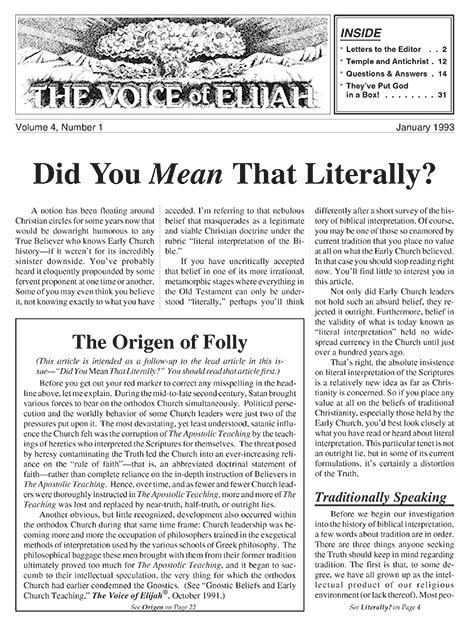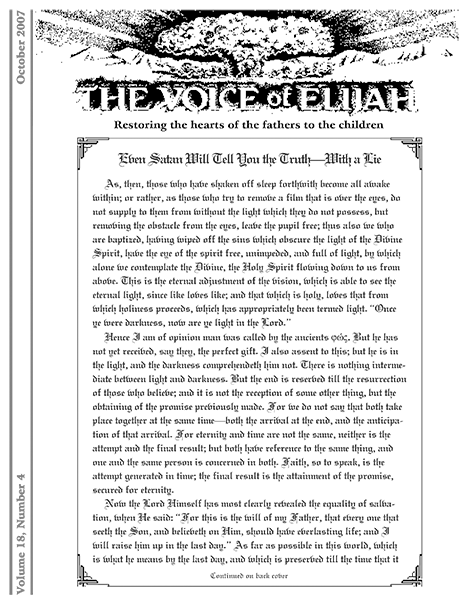Excerpt From Ebook
If you have never been warned that you might be caught in Satan’s web, you are certainly being warned now. Satan is well on his way toward accomplishing his greatest deception exactly as the Scriptures tell us he will before the End. So you had best take heed if you know what’s good for you. But before I get into explaining Satan’s deception, let me remind you what the Scriptures have to say about the Liar’s plan. In the Book of Revelation, the Apostle John refers to Satan’s deception in three different places. The first is in his description of how Satan comes to be on Earth:
And the great dragon was thrown down, the serpent of old who is called the devil and Satan, who deceives the whole world; he was thrown down to the earth, and his angels were thrown down with him.
(Revelation 12:9)
John’s second reference to Satan’s great, grand, and—as he believes—glorious deception can be found in a passage where John describes events that will occur when the Antichrist appears:
And he deceives those who dwell on the earth because of the signs which it was given him to perform in the presence of the beast, telling those who dwell on the earth to make an image to the beast who had the wound of the sword and has come to life.
(Revelation 13:14)
John’s final mention of Satan’s deception occurs in his account of Satan’s imprisonment:
And I saw an angel coming down from heaven, having the key of the abyss and a great chain in his hand. And he laid hold of the dragon, the serpent of old, who is the devil and Satan, and bound him for a thousand years, and threw him into the abyss, and shut {it} and sealed {it} over him, so that he should not deceive the nations any longer, until the thousand years were completed; after these things he must be released for a short time.
(Revelation 20:1–3)
These are not the only places in the Scriptures where Satan’s deception is mentioned, however. The Prophets talk about it all the time. For the most part, they refer to his deceit only cryptically, and they describe it in terms of parabolic imagery. The Apostle Paul does that as well, but he also outlines it openly in what he says concerning the Antichrist:
And then that lawless one will be revealed whom the Lord will slay with the breath of His mouth and bring to an end by the appearance of His coming; {that is,} the one whose coming is in accord with the activity of Satan, with all power and signs and false wonders, and with all the deception of wickedness for those who perish, because they did not receive the love of the truth so as to be saved. And for this reason God will send upon them a deluding influence so that they might believe what is false, in order that they all may be judged who did not believe the truth, but took pleasure in wickedness.
(2 Thessalonians 2:8–12)
So there you have it. The Scriptures plainly tell us Satan, in keeping with his character as the consummate Liar, is planning to do his best to wrap things up all neat and tidy here at the End by foisting off one whale of a deception on those who don’t want to know the Truth. Now, we know from what Jesus said that Satan is first and foremost a liar, and we also know from what the Apostles John and Paul tell us that he plans to “deceive the whole world” when he appears in the person of the Antichrist. So it makes sense to me (but perhaps not to you) that Satan would try to accomplish that by corrupting the Truth God has revealed in the Scriptures. That is, we should logically expect him, in whatever way he possibly can, to be constantly working to distort what Jesus Christ instructed the Church to teach.2
2Matthew 28:18–20.
Larry Dee Harper, Wanna Hear a Whopper?, pp. 2–3
Ebook Details
| Digital Copy | Free |
|---|---|
| Hard Copy | $2.00 |
| Author | Larry Dee Harper |
| Pages | 56 |
| Publisher | The Elijah Project |
| Released | August 2014 |
| Language | English |
The Truth is Available
Check Out the Online Library
Browse through our library of newsletters and booklets—absolutely free!
Start Reading Now



